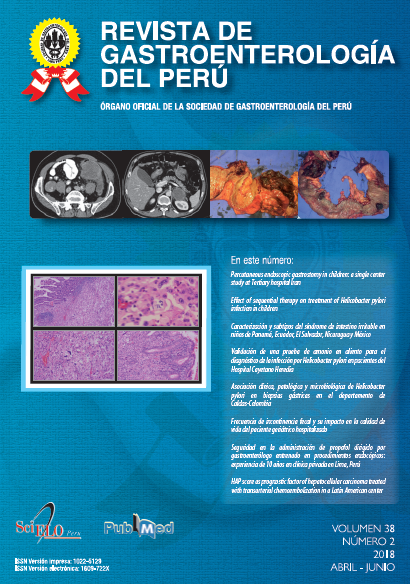Effect of sequential therapy on treatment of Helicobacter pylori infection in children
DOI:
https://doi.org/10.47892/rgp.2018.382.882Palabras clave:
Helicobacter pylori, Terapéutica, EradicationResumen
Background: Helicobacter pylori infection which plays a major role in the etiology of chronic gastritis and duodenal ulcers in children and adults is one of the commonest chronic infection worldwide. Cure of the infection leads to healing of gastric inflammation and prevention of peptic ulcer. Objective: The aim of this study was to evaluate the efficacy of the sequential therapy for treatment of Helicobacter pylori infection. Materials and methods: In this study, 40 children with symptoms of H. Pylori that the infection was proved by endoscopy and biopsy and rapid urease test (UBT) were enrolled, and received sequential therapy (Lansoprazol, Amoxicillin) for 5 days and (Lansoprazol, Metronidazole and Clarithromycin) for next 5 days. The eradication rate of therapy was evaluated by stool antigen test 6 weeks after completion of therapy. This study was carried out in Pediatric Gastroenterology Clinic of Shiraz University of Medical Sciences, Shiraz, Iran. This study was approved by ethic committee of Shiraz University of Medical Sciences. Results: Forty children with mean age of (10.8±4 years) were evaluated. The most common symptom on first admission was epigastric pain (82.5%), with mean duration of symptoms (16±14.5 month). The most common endoscopic findings was redness and erosion of the antrum (55%) and the most pathologic findings was chronic gastritis (77.5%). The most drug adverse effect was nausea (22.5%). The eradication rate of sequential therapy was 82.5%. Conclusion: Eradication rate of sequential therapy was 82.5% among our cases.Descargas
Los datos de descargas todavía no están disponibles.
Métricas
Cargando métricas ...
Descargas
Publicado
10.08.2018
Cómo citar
1.
Mohsen Dehghani S, Nazari A, Javaherizadeh H. Effect of sequential therapy on treatment of Helicobacter pylori infection in children. Rev Gastroenterol Peru [nternet]. 10 de agosto de 2018 [citado 18 de diciembre de 2025];38(2):128-30. isponible en: https://revistagastroperu.com/index.php/rgp/article/view/882
Número
Sección
ARTÍCULOS ORIGINALES
Licencia
Revista de Gastroenterología del Perú by Sociedad Peruana de Gastroenterología del Perú is licensed under a Licencia Creative Commons Atribución 4.0 Internacional..
Aquellos autores/as que tengan publicaciones con esta revista, aceptan los términos siguientes:
- Los autores/as conservarán sus derechos de autor y garantizarán a la revista el derecho de primera publicación de su obra, el cuál estará simultáneamente sujeto a la Licencia de reconocimiento de Creative Commons que permite a terceros compartir la obra siempre que se indique su autor y su primera publicación esta revista.
- Los autores/as podrán adoptar otros acuerdos de licencia no exclusiva de distribución de la versión de la obra publicada (p. ej.: depositarla en un archivo telemático institucional o publicarla en un volumen monográfico) siempre que se indique la publicación inicial en esta revista.
- Se permite y recomienda a los autores/as difundir su obra a través de Internet (p. ej.: en archivos telemáticos institucionales o en su página web) antes y durante el proceso de envío, lo cual puede producir intercambios interesantes y aumentar las citas de la obra publicada. (Véase El efecto del acceso abierto).

















 2022
2022 